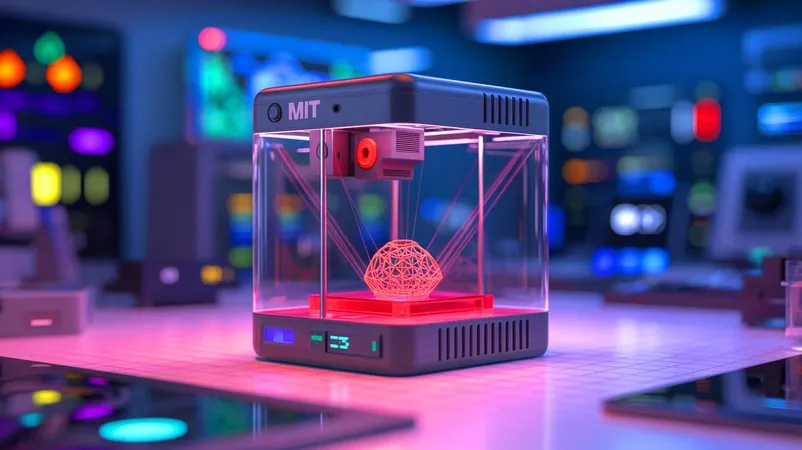
Revolutionary Chip-Based 3D Printer Creates Complex Objects in Seconds!
2025-07-04
Author: Jacques
Imagine holding an extraordinary device in your palm that can generate intricate three-dimensional objects in mere seconds! Thanks to groundbreaking research from the Massachusetts Institute of Technology (MIT), this futuristic vision is becoming a reality. Combining the fields of silicon photonics and photochemistry, researchers have unveiled a chip-based 3D printer ready to transform the manufacturing landscape.
Compact and Affordable 3D Printing Technology
This innovative 3D printing technology signals a major breakthrough in manufacturing and prototyping. Unlike traditional printers that rely on bulky mechanical systems to build objects layer by layer, this new printer utilizes a miniature photonic chip. Emitting adjustable visible-light holograms into a stationary resin, it enables the swift creation of intricate designs, all without the hassle of cumbersome machinery. The result? A lightweight, portable device that makes on-the-go printing a breeze!
Game-Changing Applications in Biology
One of the most thrilling applications of this cutting-edge technology lies in the realm of biology. A miniature "tractor beam" functionality allows for the manipulation of biological particles without any physical contact. By leveraging focused light beams, researchers can capture and move cells, leading to groundbreaking advancements in understanding DNA, disease mechanisms, and more—completely risk-free from contamination.
Endless Possibilities with Chip-Based 3D Printing
The potential impact of chip-based 3D printing technology is immense. MIT researchers foresee its application across diverse industries, including medical, military, engineering, and consumer electronics. The capability to produce custom, low-cost objects rapidly could revolutionize manufacturing processes, rendering them more efficient and environmentally sustainable.
Currently, fused deposition modeling (FDM) is the predominant consumer-level 3D printing method. However, this chip-based innovation offers a compelling alternative, significantly minimizing the time and resources required for high-resolution prints. Its compact design ensures usability in remote or resource-limited areas, sparking innovation where traditional technology falls short.
Understanding the Technology: How It Works
At the core of this invention is a photonic chip that skillfully manipulates light to achieve astonishing results. This chip directs reconfigurable light patterns into resin, solidifying into the desired shapes. While reminiscent of traditional stereolithography, it operates on a much smaller and more refined scale. The lack of moving parts simplifies the design, enhancing the printer's durability and reliability.
Researchers have successfully demonstrated a proof-of-concept for this chip-based printer, which utilizes a highly sophisticated visible-light beam-steering integrated optical phased array. This groundbreaking innovation paves the way for non-mechanical 3D printing, heralding a new era of manufacturing possibilities.
What Does the Future Hold for Manufacturing?
This cutting-edge technology isn't merely a novelty; it signifies a monumental shift in how we design and produce objects. As development continues, we can expect its proliferation in industries ranging from medicine to consumer electronics. Its efficiency and portability make it an appealing choice for diverse applications, from crafting custom medical implants to personalizing everyday items.
As we gaze into the future, one can't help but speculate how this technology will evolve. Will chip-based 3D printers one day rival the ubiquity of smartphones? What new creative avenues could they unlock that remain beyond our current imagination? The horizons for this technology are limitless, and the journey has only just begun!









 Brasil (PT)
Brasil (PT)
 Canada (EN)
Canada (EN)
 Chile (ES)
Chile (ES)
 Česko (CS)
Česko (CS)
 대한민국 (KO)
대한민국 (KO)
 España (ES)
España (ES)
 France (FR)
France (FR)
 Hong Kong (EN)
Hong Kong (EN)
 Italia (IT)
Italia (IT)
 日本 (JA)
日本 (JA)
 Magyarország (HU)
Magyarország (HU)
 Norge (NO)
Norge (NO)
 Polska (PL)
Polska (PL)
 Schweiz (DE)
Schweiz (DE)
 Singapore (EN)
Singapore (EN)
 Sverige (SV)
Sverige (SV)
 Suomi (FI)
Suomi (FI)
 Türkiye (TR)
Türkiye (TR)
 الإمارات العربية المتحدة (AR)
الإمارات العربية المتحدة (AR)